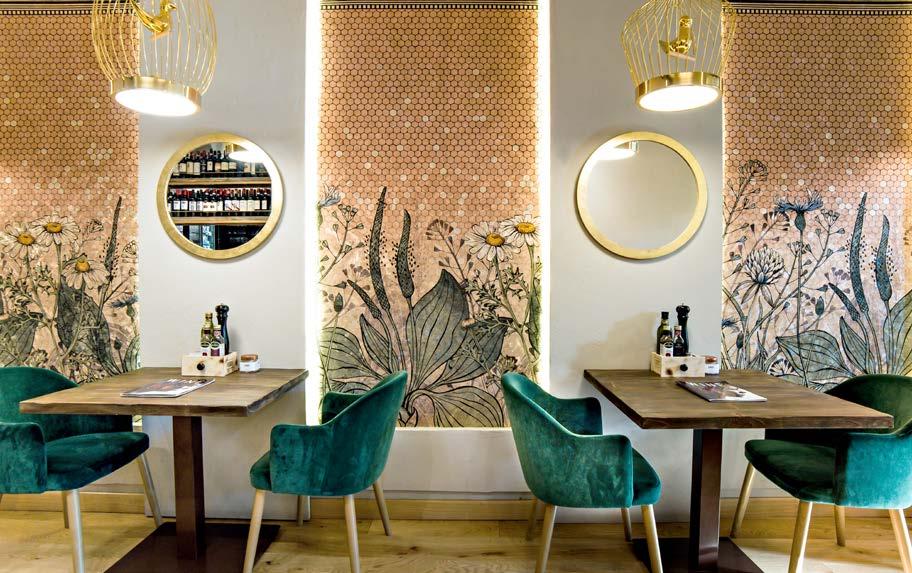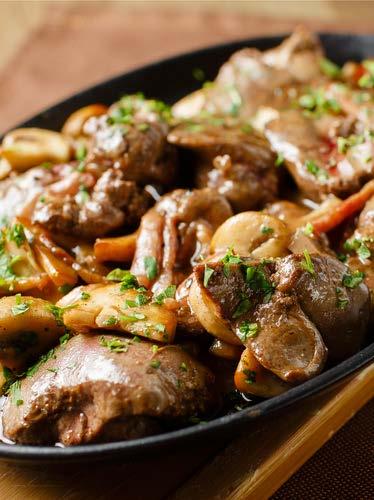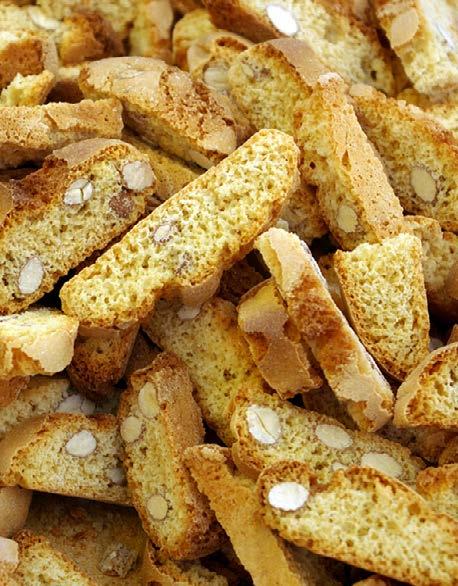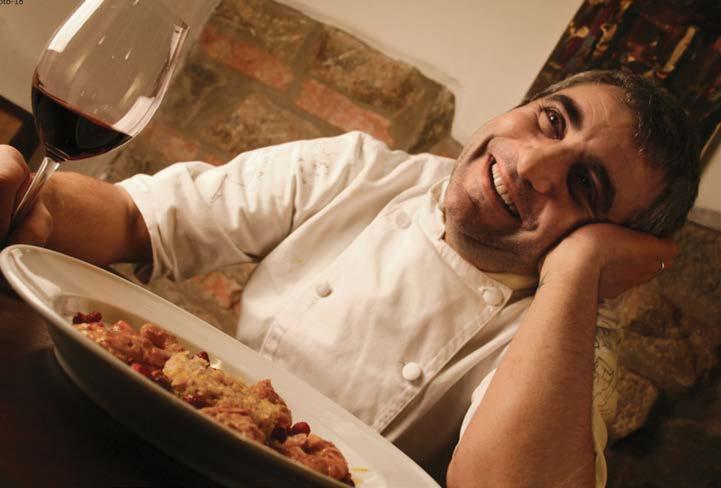
14 minute read
ONE RESTAURANT THREE SOULS
FOOD & WINE TASTING
High-quality ingredients and an elegant, welcoming environment make Foody Farm the ideal place at any time of day.
Advertisement
>> Foody Farm www.foodyfarm.it Lungarno Corsini, 2A. T: 055 242327.
This restaurant, a few yards from the Ponte Vecchio, makes the rediscovery of Tuscan raw materials, combined to bring innovative recipes to life, its distinctive feature. The specialities range from street food to tartares, as well as salads, home-made pasta, cheeses and meats, with a selection of vegetarian offers, all based on local ingredients from carefully selected small Tuscan farms. Inside the restaurant three souls Coexist: BreakFarm, from 7am to 10.30am based on the international buffet breakfast, while Farmology reinterprets the classic concept of aperitifs or after dinner drinks.
TASTING
© OKUNIN / SHUTTERSTOCK.COM PH

Genuine food for all tastes at the Central Market
Where is it possible to taste Sicilian specialities, vegan dishes, Chianina hamburgers, sushi, fresh pasta, dishes from the Tuscan tradition such as tripe and lamprey, high-quality meats, pizzas, fried food specials and artisan ice-creams, all under one roof? At the Central Market, a temple of taste located right in the city centre and housed on the first floor of the historic covered market of San Lorenzo. In this sort of modern agora for gourmets, you can also take a seat at the large convivial tables and enjoy one of the many specialities that are prepared there on the spot. In a territory such as that of Florence, which is famous for the genuineness and quality of its dishes, the aim has been to protect consumers to the maximum: all the operators at the Central Market in fact sign a quality specification whereby all the dishes prepared inside the market are cooked using only the raw materials on sale at the market itself. www.mercatocentrale.it
PH © AFRICA STUDIO/SHUTTERSTOC.COM
TASTING
>> INSIDER TIPS
• Breakfast time in Italy can be from 6am to 11am, depending on what time you got up, and it usually includes a cappuccino, which is a morning drink, and “cornetto” or other sweet pastries. • Lunchtime usually ranges from midday to 2pm (that is why many of the shops of the shops close in these hours), dinnertime from 8pm to 10pm. • Between 6pm and 9pm it’s aperitivo time, an Italian tradition started in Florence. If you’re feeling hungry between 3pm and 5pm then it’s time for you to have a “merenda”, a quick snack between the two main meals. Should you be hungry at late night, you can check several list of late-night restaurants in Florence. • Never forget to check the restaurant’s weekly closing day, which – most of the time – will be Monday. • Reservations for most restaurants are strongly advised. • In Italy, service is included in the price meaning that although tipping is not compulsory but it is obviously appreciated as a sign of satisfaction. • Some menus include the word “coperto”, a small surcharge corresponding to the cost of the service and bread (usually between 1 and 3 euros per person). • If you want tap water, you should specify it to the waiting staff of the restaurant or bar, asking for a glass of “acqua di rubinetto”. • Although no dress code exists in Italy, semiformal clothing is usually considered de rigeur at restaurants. • All restaurants and bars are non-smoking unless a separate smokers’ area is specifically offered.
TASTING
2022 MICHELIN-STARRED RESTAURANTS
In addition to the historic and well established Enoteca Pinchiorri, with its prestigious three Michelin stars, there are six other Florentine restaurants that have been awarded one star.

Enoteca Pinchiorri Santa Elisabetta

Enoteca Pinchiorri
Via Ghibellina, 87. T: 055 242757 enotecapinchiorri.it How do you manage to be honoured with three Michelin stars, the highest recognition, which is only achieved by a hundred restaurants worldwide? In the case of the Enoteca Pinchiorri, it comes from the winning combination of prime quality raw materials, the search for innovation, yet without forgetting the territory’s (great) culinary tradition, obsessive attention to every detail and an unrivalled wine menu, which includes highly prized labels, along with others that are little known but equally interesting. Then we can add the fact that the restaurant is located inside the 18th-century Palazzo Jacometti-Ciofi and that its desserts are a delight for the senses.
TASTING
Santa Elisabetta
Piazza Santa Elisabetta, 3. T: 055 27370 www.ristorantesantaelisabetta.it In the heart of the historical centre of Florence, a unique location, the Byzantine Pagliazza Tower: built around 541-544 AD, today it is part of the register of historical Florentine buildings. Santa Elisabetta is on the first floor of the tower, with a particular circular shape, in an intimate atmosphere that only houses seven tables. Its menu respects nature and the seasons. The Chef chooses to experiment with minimalism, on dishes with a single product that is the protagonist and two or three others that act as a support. Each dish is characterized by the contrasts between acidity and sweetness, cooked and raw, sapidity and lightness.
Borgo San Jacopo c /o Hotel Lungarno Borgo San Jacopo, 62/r. T: 055 281661 www.borgosanjacopo.com Overlooking the banks of the Arno, with a picture postcard view of Ponte Vecchio, the restaurant Borgo San Jacopo is perfect for a romantic evening. In this case the winning recipe is one that blends creativity, tradition and quality ingredients (lamb in sea water or Bresse rooster and octopus are an example of this), all washed down with wines chosen from a cellar of 900 labels. You can opt for the tasting menu (the potato-based one is unmissable) or à la carte.
Borgo San Jacopo

Ribollita calssica..e croccante
TASTING

La Leggenda dei Frati Gucci Osteria da Massimo Bottura

Gucci Osteria da Massimo Bottura
Piazza della Signoria, 10. T: 055 75927038 www.gucci.com/it/it/store/osteria-bottura Located inside inside the Gucci Garden, the creative liaison between Gucci and Bottura celebrates two things Italy is renowned for: fashion and fine cuisine. Head of the team is Mexican chef Karime Lopez Kondo. The menu is an explosive blend of flavours ranging from Italy to the Orient and offers cosmopolitan titbits such as the “Taka-ban”, the classic Japanese steamed bun with pork belly and spicy sauce, or marinated Adriatic palamita with tortilla or fried aubergines in shiso sauce. In a very intimate setting, the bistro plays around the tones of green and pistachio and can welcome up t o 35 diners indoors.
La Leggenda dei Frati
c/o Villa Bardini Costa S. Giorgio, 6/a. T: 055 0680545 www.laleggendadeifrati.it Inside the Villa Bardini museum complex in Costa San Giorgio is the one-star restaurant La Leggenda dei Frati helmed by chef Filippo Saporito and his wife Ombretta Giovannini. A breathtaking view over Florence and across vineyards at the
TASTING
rear, these are just the cherry on the cake of a creative culinary proposal, which in this case too draws its inspiration from the local tradition, with a propensity for quality meat (the boiled sausages and ’soppressata’ are self-produced), but also for vegetables picked directly from the restaurant’s own vegetable and herb garden and for the hand-made bread using flour from ancient grains.
Il Palagio
Borgo Pinti, 99. T: 055 2626450 www.ilpalagioristorante.it Inside the Hotel Four Seasons, in a sophisticated environment with tables both indoors and outdoors, Il Palagio bases itself on a culinary proposal that looks to the Italian and regional tradition with a touch of modernity, as in the terrine of foie gras with Vin Santo gelée or cheese and pepper cavatelli with red shrimps and baby squid. Chef Vito Mollica offers a menu that is a symphony of flavours, raw materials and colours, at times venturing far beyond the confines of Tuscany with dishes based on truffle, wagyu beef or three kinds of caviar. The wine menu includes more than 400 labels, 50 of which also served by the glass.

Il Palagio
TASTING
FLORENTINE FOOD TERMS
Florence has a multitude of culinary specialities of peasant origin that are still very popular in the city today. Some are so niche as to be unknown outside Florence. So we’ve decided to put together a glossary of Florentine food terms to help you find your way...
Buca Mario

BISTECCA ALLA FIORENTINA This is one of the most iconic dishes in Florence cuisine. The succulent steak is obtained from a specific cut of a young Chianina cow, a part of the loin near the backbone which has a T-bone in the middle. It should be grilled at a very high temperature, so that a fine crust forms rapidly on the meat. All the flavour of this dish depends on the cooking: the meat must be brown on the outside but red, soft and juicy on the inside, hot, but not cooked through. It should also be at least 3 or 4 cms thick, and weigh between 1.2 kg and 1.5 kgs. At a restaurant you pay for a fiorentina by weight: an average price to be sure of getting the real thing is around 50 euros a kilo.
TASTING
CANTUCCI This is one of the best-known cake recipes in Tuscan cuisine. The finger-shaped almond biscuits are made by slicing up a long roll of baked dough while still hot. The dough is made with flour, sugar, eggs, butter and raw almonds, not toasted or shelled. Tuscans normally dunk their ’cantucci’ in a fortified local wine called Vin Santo made from dried grapes. You can find them in any bakery or local foods shop.
CIBREO A dish for strong stomachs, Cibreo is a typical main course of Florentine “poor cuisine” containing liver, chicken hearts, crests, eggs, lemon juice and onion. Even though presented like that it seems to be an inauspicious mixture, it is famous for having been one of the favourite dishes of Caterina de’ Medici, who attempted - unsuccessfully - to export it to France and it seems she was so fond of it that it gave her indigestion a number of times.
Cantucci Cibreo


TASTING
LAMPREDOTTO This is Florentine street food par excellence. But watch out, it’s not for weak stomachs. Actually it’s a cow’s fourth stomach, known as the ’abomaso’, cooked in a herb broth and most commonly served in a panino soaked in the broth or topped with the local parsleybased green sauce. Historically a poor man’s dish, it is still very popular in Florence today thanks to the numerous open-air kiosks known as “lampredottai”, doing a roaring trade with Florentines as well as tourists who can’t wait to try this speciality, accompanied by the obligatory glass of wine.
PAPPA COL POMODORO On the face of it this is just another variant of bread and tomatoes. But until you’ve tried this soup made of stale bread (unsalted), tomatoes, garlic, basil, extra virgin Tuscan olive oil, salt and pepper, you’ll never guess how good it is. Everyone loves this tasty, genuine dish, including the kids. So much so there’s even a popular children’s song all about it.
Lampredotto Pappa col pomodoro


Ribollita
TASTING

© MARCO MAYER PH
Schiacciata

RIBOLLITA Another delicious country dish typical of Florence and the whole of central Tuscany is ribollita, a soup made of stale bread, kale and beans (borlotti, toscanelli or cannellini). ’Ribollita’ literally means boiled several times. The name derives from the fact that in the old days peasants used to make a large pot and serve it, heated up, over a number of days, each time tastier than before.
SCHIACCIATA This simple focaccia baked in a wood oven and dressed with olive oil and salt is a great favourite with Florentines, who eat it on its own or stuffed with salumi and cheeses, either as a quick lunch or substantial snack. Again, like many traditional Florentine recipes, it is based on a horror of wasting any left over bread dough. In Florence you’ll find it at any baker’s, but of course everyone has their own preference: soft and well oiled, crisp and salty, or made with ancient grains. Just try it to decide which is your favourite!
TASTING
HISTORIC CELLARS FOR FOODIES
Florence’s cantine, where in the past the well to do kept their wine, salumi and meats, haven’t lost their vocation as custodians of fine taste. The majority are still called “buca”, although some have become proper restaurants, while others still offer authentic Florentine home cooking.
Antica Mescita San Niccolò Ever wanted to eat lunch in a 1000 AD Romanesque crypt? In Florence you can, at the Antica Mescita San Niccolò, which also used to serve as a customs post for wine originating from Chianti. Naturally, the wine is excellent and predominately Tuscan and the food also reflects the season and the local territory, with dishes such as cold cuts and mixed cheeses, ribollita, bistecca alla fiorentina and lampredotto, to name just a few. www.osteriasanniccolo.it Via San Niccolò, 60/r. T: 055 2342836.
Antica Mescita San Niccolò

Buca Lapi
TASTING
Buca Lapi Buca Lapi is one of Florence’s oldest eating places. Crafted out of the wine cellars of the Renaissance Palazzo Antinori, it still preserves traces of over a century of history thanks to the meticulous restoration of the internal frescoes. Buca Lapi is particularly popular with lovers of the real fiorentina, but the other local Tuscan dishes are worth trying too, such as croutons, ribollita or wild boar with polenta. The bill won’t be particularly easy on the pocket, especially if you go for the steak, but as we know quality doesn’t come cheap. www.bucalapi.com. Via del Trebbio 1/r. T: 055 213768.

Buca Mario For years ordinary folk have rubbed shoulders with famous names beneath the bare brick ceilings of Buca Mario to enjoy simple, genuine Florentine cuisine (although you can still request a private room for up to ten people in classic 16th century Florentine style). The bistecca alla fiorentina is excellent, as is the ribollita or pappardelle with Maremma boar ragù. www.bucamario.com Piazza degli Ottaviani, 16/r T: 055 214179.
TASTING
Buca Poldo A few yards from Piazza della Signoria and Ponte Vecchio, Buca Poldo serves characteristic Tuscan dishes including ribollita, pappa al pomodoro, fiorentina and boar stew, as well as a few forays into other regional cuisines. Although the majority of the courses are meat based, some fish dishes are also available. The kitchen is open on two sides, so that diners can watch the chefs at work. www.bucapoldo.com Chiasso degli Armagnati, 2/R. T: 055.239.6578.
Buca San Giovanni Buca San Giovanni is another of Italy’s historic restaurants. Originally the sacristy of the nearby Baptistery of Saint John opposite Florence cathedral, it was also the Rosicrucian masons’ secret initiation venue and countless notables from Florence and elsewhere have enjoyed a meal under its ancient vaults. There is no lack of classic dishes such as ossobuco alla Fiorentina (oxtail) and stracotto al Chianti (beef braised in Chianti), but the cuisine also stretches to other Italian regional specialities, such as bucatini all’amatriciana, spaghetti alla carbonara or linguine al pesto. www.bucasangiovanni.it Piazza San Giovanni, 8. T: 055 287612
Buca San Giovanni

Buca dell'Orafo
TASTING
Fiaschetteria Nuvoli Just a few steps from Piazza Duomo is an obligatory destination for anyone who has ever wondered what Florence’s old wine cellars were really like in the past. Open from 8.30 in the morning until evening, it serves typical Tuscan specialities such as chicken liver croutons, cold cuts, tagliatelle al ragù, fried chicken or brains, ribollita, pappa col pomodoro and roast porchetta. There is also a vast choice of Tuscan wines, also available for aperitifs. Piazza dell’Olio, 15/r. T: 055 239 6616.

Ristorante Buca dell’Orafo A few yards from Ponte Vecchio, in an old goldsmith’s workshop inside the walls of a 13th century palace, is the restaurant Buca dell’Orafo. Traditional Tuscan dishes and menus that vary depending on the season testify to the quality of the ingredients. Don’t miss the ribollita, the maltagliati (flat, irregular offcuts of pasta), autumn mushrooms and taglierini with fresh spring peas. www.bucadellorafo.com Via dei Girolami, 28/r. T: 055 213619.







